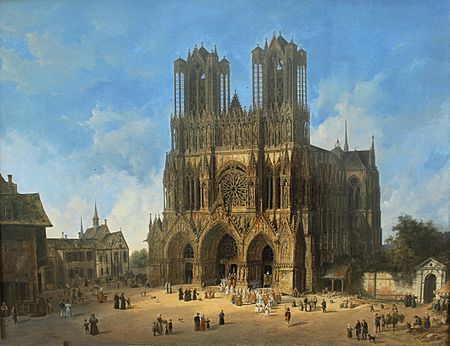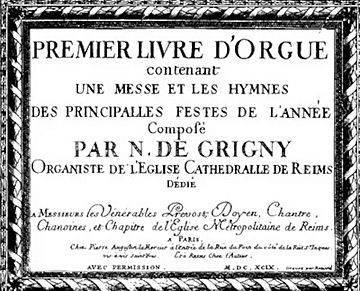Nicolas de Grigny facts for kids

Nicolas de Grigny (baptized September 8, 1672 – November 30, 1703) was a talented French organist and composer. He passed away at a young age, leaving behind only one collection of organ music and a piece for the harpsichord called an Ouverture.
Contents
Who Was Nicolas de Grigny?
Nicolas de Grigny was born in Reims, France. We don't know his exact birthday, but he was baptized on September 8. He came from a family of musicians. His father, grandfather, and uncle were all organists in different churches in Reims.
Early Life and Training
Not much is known about Grigny's early years. However, we do know he worked as an organist at the Saint Denis Abbey church in Paris between 1693 and 1695. During this time, he studied with Nicolas Lebègue. Lebègue was a very famous French keyboard composer back then.
In 1695, Grigny married Marie-Magdeleine de France. She was the daughter of a merchant from Paris. Soon after, he moved back to his hometown of Reims. Records show he was already in Reims by 1696 when his first son was born. Nicolas and Marie-Magdeleine had six more children together.
Organist at Reims Cathedral
By late 1697, Grigny became the main organist at Notre-Dame de Reims. This famous cathedral in Reims was where French kings were traditionally crowned. It was a very important position.
In 1699, Grigny published his main work in Paris. It was called Premier livre d'orgue, which means "First Book of Organ Music." It included music for a church mass and hymns. Sadly, Grigny died young in 1703, when he was only 31 years old. He had just accepted a new job at another church in Reims.
His Music Lives On
Grigny's wife helped to re-release his Livre d'orgue in 1711. This collection of music became well-known even outside of France. A famous composer named Johann Sebastian Bach copied the entire collection by hand in 1713. Another composer, Johann Gottfried Walther, also copied it later. This shows how important Grigny's music was considered.
Nicolas de Grigny's Music
Nicolas de Grigny's only surviving music is his large book of organ works. It's called Premier livre d'orgue and was first published in 1699. A second edition came out in 1711. For a long time, only the 1711 version was known. But in 1949, a single copy of the original 1699 print was found. It was at the Bibliothèque nationale de France in Paris.
What's Inside the Organ Book?
Unlike other organ music books from that time, Grigny's book doesn't have a long introduction. The collection is divided into two main parts:
- The first part is music for a church mass.
- The second part has music for five important hymns used during church holidays.
In total, there are 42 different pieces of music in the book.
Music for the Mass
The mass music in Grigny's book follows a specific structure:
- 5 pieces for the Kyrie
- 9 pieces for the Gloria
- An Offertory piece
- 2 pieces for the Sanctus
- 1 piece for the Benedictus
- A piece for the Elévation
- 2 pieces for the Agnus Dei
- A Communion piece
- 1 piece for the Ite Missa Est
Grigny used traditional church melodies in some of his pieces. For example, he used melodies in the first and last Kyrie, Gloria, and the first Sanctus and Agnus Dei sections. His collection is based on a chant called Cunctipotens genitor Deus. The book also includes a special piece called a Point d'orgue. This piece is built around a long, held note played on the organ's pedalboard.
See also
 In Spanish: Nicolas de Grigny para niños
In Spanish: Nicolas de Grigny para niños
- French organ school


